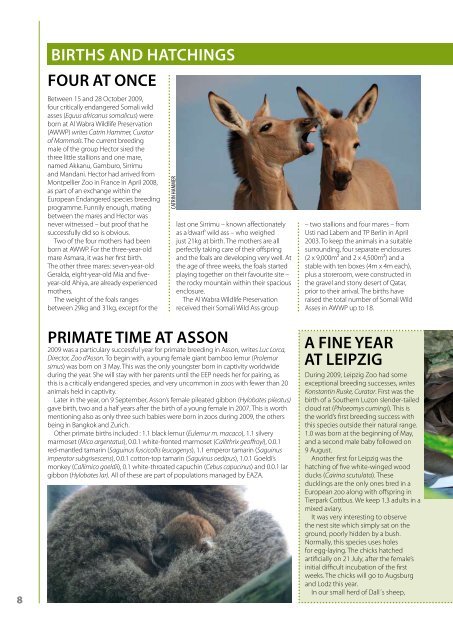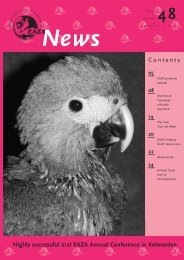Spring 2010 - European Association of Zoos and Aquaria
Spring 2010 - European Association of Zoos and Aquaria
Spring 2010 - European Association of Zoos and Aquaria
You also want an ePaper? Increase the reach of your titles
YUMPU automatically turns print PDFs into web optimized ePapers that Google loves.
8<br />
births <strong>and</strong> hatchings<br />
Four at once<br />
Between 15 <strong>and</strong> 28 October 2009,<br />
four critically endangered Somali wild<br />
asses (Equus africanus somalicus) were<br />
born at Al Wabra Wildlife Preservation<br />
(AWWP) writes Catrin Hammer, Curator<br />
<strong>of</strong> Mammals. The current breeding<br />
male <strong>of</strong> the group Hector sired the<br />
three little stallions <strong>and</strong> one mare,<br />
named Akkanu, Gamburo, Sirrimu<br />
<strong>and</strong> M<strong>and</strong>ani. Hector had arrived from<br />
Montpellier Zoo in France in April 2008,<br />
as part <strong>of</strong> an exchange within the<br />
<strong>European</strong> Endangered species breeding<br />
programme. Funnily enough, mating<br />
between the mares <strong>and</strong> Hector was<br />
never witnessed – but pro<strong>of</strong> that he<br />
successfully did so is obvious.<br />
Two <strong>of</strong> the four mothers had been<br />
born at AWWP. For the three-year-old<br />
mare Asmara, it was her first birth.<br />
The other three mares: seven-year-old<br />
Geralda, eight-year-old Mia <strong>and</strong> fiveyear-old<br />
Ahiya, are already experienced<br />
mothers.<br />
The weight <strong>of</strong> the foals ranges<br />
between 29kg <strong>and</strong> 31kg, except for the<br />
catrin hammer<br />
last one Sirrimu – known affectionately<br />
as a ‘dwarf’ wild ass – who weighed<br />
just 21kg at birth. The mothers are all<br />
perfectly taking care <strong>of</strong> their <strong>of</strong>fspring<br />
<strong>and</strong> the foals are developing very well. At<br />
the age <strong>of</strong> three weeks, the foals started<br />
playing together on their favourite site –<br />
the rocky mountain within their spacious<br />
enclosure.<br />
The Al Wabra Wildlife Preservation<br />
received their Somali Wild Ass group<br />
Primate time at asson a Fine year<br />
at LeiPzig<br />
2009 was a particulary successful year for primate breeding in Asson, writes Luc Lorca,<br />
Director, Zoo d’Asson. To begin with, a young female giant bamboo lemur (Prolemur<br />
simus) was born on 3 May. This was the only youngster born in captivity worldwide<br />
during the year. She will stay with her parents until the EEP needs her for pairing, as<br />
this is a critically endangered species, <strong>and</strong> very uncommon in zoos with fewer than 20<br />
animals held in captivity.<br />
Later in the year, on 9 September, Asson’s female pileated gibbon (Hylobates pileatus)<br />
gave birth, two <strong>and</strong> a half years after the birth <strong>of</strong> a young female in 2007. This is worth<br />
mentioning also as only three such babies were born in zoos during 2009, the others<br />
being in Bangkok <strong>and</strong> Zurich.<br />
Other primate births included : 1.1 black lemur (Eulemur m. macaco), 1.1 silvery<br />
marmoset (Mico argentatus), 0.0.1 white-fronted marmoset (Callithrix ge<strong>of</strong>froyi), 0.0.1<br />
red-mantled tamarin (Saguinus fuscicollis leucogenys), 1.1 emperor tamarin (Saguinus<br />
imperator subgrisescens), 0.0.1 cotton-top tamarin (Saguinus oedipus), 1.0.1 Goeldi’s<br />
monkey (Callimico goeldii), 0.1 white-throated capuchin (Cebus capucinus) <strong>and</strong> 0.0.1 lar<br />
gibbon (Hylobates lar). All <strong>of</strong> these are part <strong>of</strong> populations managed by EAZA.<br />
– two stallions <strong>and</strong> four mares – from<br />
Usti nad Labem <strong>and</strong> TP Berlin in April<br />
2003. To keep the animals in a suitable<br />
surrounding, four separate enclosures<br />
(2 x 9,000m² <strong>and</strong> 2 x 4,500m²) <strong>and</strong> a<br />
stable with ten boxes (4m x 4m each),<br />
plus a storeroom, were constructed in<br />
the gravel <strong>and</strong> stony desert <strong>of</strong> Qatar,<br />
prior to their arrival. The births have<br />
raised the total number <strong>of</strong> Somali Wild<br />
Asses in AWWP up to 18.<br />
During 2009, Leipzig Zoo had some<br />
exceptional breeding successes, writes<br />
Konstantin Ruske, Curator. First was the<br />
birth <strong>of</strong> a Southern Luzon slender-tailed<br />
cloud rat (Phloeomys cumingi). This is<br />
the world’s first breeding success with<br />
this species outside their natural range.<br />
1.0 was born at the beginning <strong>of</strong> May,<br />
<strong>and</strong> a second male baby followed on<br />
9 August.<br />
Another first for Leipzig was the<br />
hatching <strong>of</strong> five white-winged wood<br />
ducks (Cairina scutulata). These<br />
ducklings are the only ones bred in a<br />
<strong>European</strong> zoo along with <strong>of</strong>fspring in<br />
Tierpark Cottbus. We keep 1.3 adults in a<br />
mixed aviary.<br />
It was very interesting to observe<br />
the nest site which simply sat on the<br />
ground, poorly hidden by a bush.<br />
Normally, this species uses holes<br />
for egg-laying. The chicks hatched<br />
artificially on 21 July, after the female’s<br />
initial difficult incubation <strong>of</strong> the first<br />
weeks. The chicks will go to Augsburg<br />
<strong>and</strong> Lodz this year.<br />
In our small herd <strong>of</strong> Dall´s sheep,

















